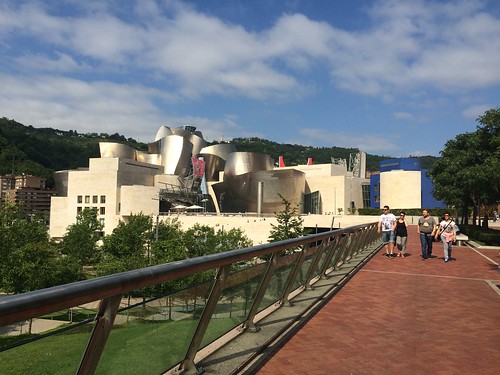New York and Bilbao are different in so many ways. The population variation alone screams out for attention. Bilbao, which is in northern Spain, is home to 350,000 residents in the city proper, and one million people in its entire metropolitan region. You could fit two and a half of those in Brooklyn alone.
And yet, having spent the last five days there for an academic conference at the University of Deusto, I can say there are aspects of Bilbao that are very reminiscent of New York. I was there for a conference that delved into the topic of the creative industries, but I also learned a great deal about post-industrial waterfront development, a topic that is very much on the minds of New Yorkers these days. I got to talk about my book, and although I may share that talk soon, I want to focus more on this fascinating city while it’s still on my mind. After all, I still have a bit of time to focus on the book before it hits the streets on August 28.
 |
| Look at me ma, I'm talking about graffiti! |

Aerial view of Zorrotzuarre By Fernandopascullo - Own work, CC BY-SA 3.0, Link
Parallels between Red Hook are not too far off base, except Zorrotzaurre is even closer to the center of Bilbao than that struggling Brooklyn port. On my first morning there, I ran from my hotel, which was next door to the gargantuan Frank Gehry-designed Guggenheim, to a section of it in less than 15 minutes.
 | |
| The Guggenheim |
What I found was amazing. In addition to a few token light industries, I found buildings lining narrow alleys that appeared on the verge of collapse. Roughly 500 people call Zorrotzaurre home, but from the looks of it, nearly as many graffiti writers call it home as well. As they should, right? Is there anything better than brightly adorned decay, augmented by scads of flora bent on reclaiming a space?
 |
| Anybody home? |
 | |
| A butter cup grows in Spain. |
 |
| The Basque Health Department Headquarters, by Coll-Barreu Arquitectos. How they ever wash the windows is beyond me. |
And transformed, it will be, by the architect Zaha Hadid, into a brand spanking neighborhood, for 5,000 residents. Some buildings will be saved, and the master plan has space for “creative industries” as well as housing. But when I asked my hosts if there were any plans to include the artists who have taken over the streets of the neighborhood in the mean time, the answer was no. Sound familiar?
Alas, the other quality that Bilbao would seem to have in common with New York is a predilection for top-down initiatives. The logic would seem to be, a space is in a prime location, and is on the water to boot, so wholesale redevelopment is in order, and since graffiti is so ubiquitous around the city that it would cause Bill Bratton to break out in hives, no need to worry if a few blocks of it is demolished in the name of progress, right?
 |
| We got yer master plan right here! |
There are other concerns about the future of Zorrotzaurre regarding finances, transportation and housing, but the absence of street art in the plan is most baffling to me. To me, the seven or eight gritty and chaotic blocks of art there are representative of the kind of grass roots creativity that is craved by urban dwellers. How that happens, I’m not sure. Jerry Wolkoff’s proposal to invite artists to paint on a space that replaces the old 5 Pointz isn’t the answer, but I suppose that neither is simply leaving one section completely alone, destined to crumble back into earth.
 |
| Step right this way to art town. |
Surely there must be a middle ground? If it can be found, Bilbao would seem to be a good place for it to happen. Scholars at the University of Deusto are trying to measure the impact of “creative industries” beyond economic measures, an ambitious and intriguing endeavor. And although shiny new spaces like the Guggenheim and the Metro are (more or less) pristine, residents are content to hand over older, less prestigious spaces to artists, even in Casco Viejo, the neighborhood where the city was founded in 1300.
 |
| Star boy and me; we go way back. |
Like the pictures? I've got a SHIT TON more here!
